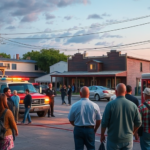TxDOT Pavement Work Prompts Closures and Delays on Interstate 2
Residents and commuters throughout the Rio Grande Valley (RGV) are bracing for potential disruptions as the Texas Department of Transportation (TxDOT) embarks on a significant pavement improvement project between Palmview and Mission. The initiative underscores the ongoing efforts to enhance infrastructure while also posing logistical challenges for Valley residents who rely on this vital corridor.
Project Overview: Enhancing Road Safety and Longevity
TxDOT’s project involves the rehabilitation of ten miles of pavement along Interstate 2, aiming to improve safety and extend the road’s lifespan. The agency has outlined a phased approach to minimize disruption, yet significant closures and delays are anticipated. According to TxDOT spokesperson Mario Hernandez, “This project is crucial for maintaining the long-term viability of our transportation infrastructure, ensuring safe and efficient travel for all South Texas motorists.”
The improvements will include resurfacing the roadway and upgrading existing guardrails and signage, initiatives that are essential given the high volume of traffic on this route, which connects the bustling cities in the Valley and serves as a gateway to international trade.
Local Impact: Balancing Progress with Inconvenience
Despite the advantages presented by the upgrades, the project will inevitably affect daily routines and commuting patterns for RGV residents. Frequent travelers between Palmview and Mission should prepare for adjusted schedules as TxDOT has announced possible overnight lane closures and detours to alleviate daytime congestion.
Community member Rosa Martinez, who commutes daily from Palmview to Mission for work, expressed her concerns about the forthcoming changes: “While I’m glad to see improvements in our roads, I worry about the additional travel time and how it might affect my job. Clear communication from TxDOT will be key.”
TxDOT has responded by developing a robust communication plan, using digital platforms and local media outlets to update commuters on progress and closures. They encourage Valley residents to utilize their website and social media channels for real-time information.
Connecting with Previous Upgrades
This project is part of broader efforts to upgrade South Texas’s transportation network, following recent projects including the expansion of key highways and the installation of advanced traffic management systems. In the past, the Valley’s rapid growth has outpaced its infrastructure, leading to congestion and safety issues. Addressing these challenges remains a top priority for the state and local governments.
Unexpected Challenges: Economic Implications
While the construction may inconvenience local travelers, it bears significant economic implications. Improved infrastructure is crucial for supporting the RGV’s economic growth, particularly amid efforts to attract new businesses and enhance regional trade capabilities. The completed project will facilitate smoother transport of goods, forming a more robust connection between local businesses and international markets.
Ernesto Chavez, a local business owner in Mission, highlighted the potential benefits: “A smoother, safer highway can increase efficiency in logistics and delivery for small businesses like mine. It presents opportunities to serve more customers within and beyond the Valley.”
Future Considerations: Planning for Further Development
As TxDOT progresses with its pavement improvements, it also lays the groundwork for future infrastructure advancements. Their strategic plan extends beyond immediate repairs, aiming to address future needs linked to population growth and increased commerce. This proactive stance will be vital in anticipating the demands of a dynamic RGV community.
However, balancing such advancements with environmental considerations remains a pivotal concern. According to Dr. Lisa Gonzalez, an urban planning academic at the University of Texas Rio Grande Valley, “Careful evaluation of environmental impact and community health must accompany these infrastructure projects to ensure sustainable development.”
Resources for the Community: Remaining Informed
To help Valley residents navigate the changes brought about by this project, TxDOT is partnering with local organizations and community leaders to disseminate crucial information, ensuring everyone has access to necessary updates. Residents are encouraged to attend informational sessions and stay engaged with local media for ongoing coverage.
In conclusion, while the TxDOT pavement project suggests temporary setbacks for daily commuters, it stands as a testament to the Valley’s commitment to long-term progress and prosperity. As construction barrels line Interstate 2, the community holds anticipation for smoother and safer travels in the near future, exemplifying South Texas’s resilient spirit amid transition.







